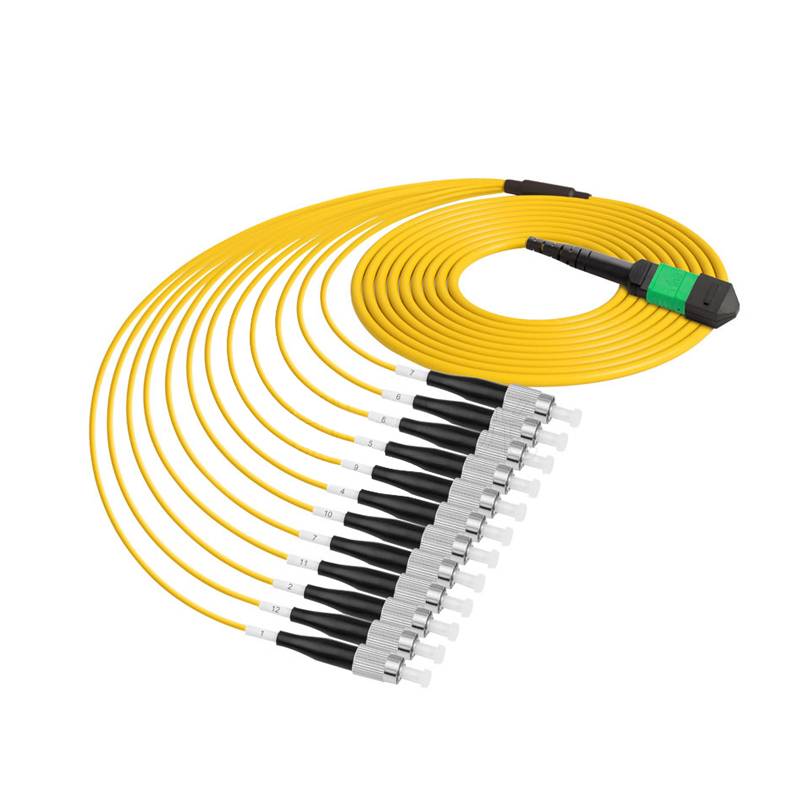FC to MPO breakout cable are mainly used in hybrid scenarios that require high-density fiber connections and compatibility with traditional device interfaces. Its core value lies in solving the adaptation problem between multi-core high-speed transmission and single-port devices.
FC to MPO breakout cable is a key transition solution in the iteration process of modern communication equipment, and is particularly suitable for scenarios that pursue high density and protect historical investments. With the popularity of 400G optical modules, MPO to LC breakout cables are gradually replacing some FC to MPO applications, but FC interfaces are still irreplaceable in high-reliability fields such as military and medical.
The following are typical application and technical analysis:
Hybrid deployment of new and old equipment in data centers
High-density backbone network access to traditional equipment: The MPO end is connected to a 40G/100G switch (MPO interface), and the FC end is connected to an old server, storage array or test instrument using an FC port. For example, a 24-core MPO backbone link is converted to a 12-pair FC interface through a branch jumper, achieving seamless connection between high-speed networks and traditional SAN storage devices.
Space optimization: A single MPO jumper replaces multiple single-core jumpers, reducing 90% of the wiring volume in the cabinet, and is suitable for space-constrained data center edge areas.

Telecom transmission network transformation
Metro backbone network compatibility upgrade : The MPO end is connected to the multi-core optical module of the DWDM/CWDM system, and the FC end is connected to the original SDH equipment or optical terminal to avoid network disconnection caused by interface mismatch.
Base station equipment interconnection : MPO trunk optical cable is used between RRU (radio unit) and BBU (baseband unit), and transmission equipment with FC interface is connected through MPO-FC jumper to improve the deployment efficiency of 5G fronthaul network.

Testing and maintenance scenarios
Multi-channel parallel detection: Take advantage of the 12/24-core integration of MPO to quickly connect to OTDR or optical power meter, and adapt the FC end to single-port detection equipment, significantly improving the efficiency of multi-core fiber link testing.
Temporary emergency connection: When the fiber link fails, quickly build a backup path through the MPO-FC jumper to ensure the continuity of key services.

Key points of technical adaptation
| Features | MPO terminal | FC end | Adaptation requirements |
| Interface density | 12/24/48 core high-density integration | Single port | Branch or fan-out design is required |
| Polarity management | A/B/C polarity (Key direction) | No polarity requirement | The jumper needs to be configured as type B (cross polarity) |
| Insertion loss control | ≤0.7dB (multi-mode) | ≤0.3dB | Low-loss ceramic ferrules are required |
| Application rate | Support 40G-400G Ethernet | Common 1G-10G | High-speed to low-speed compatibility |
Project Case: Financial data center storage network upgrade
Requirements: Keep the EMC storage array with FC-SAN architecture and access the 100G Spine-Leaf network at the same time
Solution:
① Leaf switch (MPO-24 interface) → MPO trunk cable → MPO distribution box
② Distribution box output → FC to MPO breakout cable (24 core to 12 pairs of FC connectors) → FC switch → storage device
Results: above solution save 75% of cabinet space, reduce latency to us level, and support smooth expansion to 400G in the future.
Precautions for use FC to MPO breakout cable
Polarity check: The MPO end must strictly select type A (straight-through), type B (crossover) or type C (crossover in pairs) jumpers according to the order of the device TX/RX ports. Incorrect configuration will cause signal interruption.
Cleaning and maintenance: The MPO multi-core interface is easily affected by dust. It is recommended to use a special MPO cleaning pen and check the integrity of the guide pin (PIN pin) before plugging and unplugging.
Bending radius: The bending radius of the jumper must be greater than 30mm (such as the sheath diameter is 3mm) to avoid micro-bending losses affecting high-speed signals.
FC To MPO Breakout Cable FAQ
How to correctly install an MPO to FC breakout cable?
The FC connector needs to be fixed by holding the metal threaded ring and rotating it. Do not pull the cable. The MPO fiber connector needs to be aligned with the guide pin hole and pushed axially to prevent scratching the end surface. In addition, it is recommended to use wide temperature or armored shell jumpers in extreme temperatures (-20℃~70℃). LSZH flame-retardant outer sheath materials are preferred in chemical areas.
How long is the life of an FC MPO breakout cable?
The theoretical life of an MPO-FC patch cord is 10-15 years, but it can be significantly extended in actual use by the following measures:
- Use an optical power meter + microscope to detect loss and end face status every quarter (replace in time if abnormal).
- Select LSZH flame-retardant outer sheath + armor layer protection design;
- Strictly maintain the minimum bending radius ≥ 30mm to avoid bundling and compression;
Tip: It is recommended to replace the patch cord every 5 years in industrial scenarios, and an 8-year replacement cycle is recommended in high-load environments in data centers. If the patch cord has been physically deformed or the loss exceeds the standard, it must be stopped immediately to avoid link failures.
What is the price of MPO to FC patch cords?
Yingda is a manufacturer of FC to MPO breakout able, always help save a lot of budget for customer with high-quality products at competitive prices.

